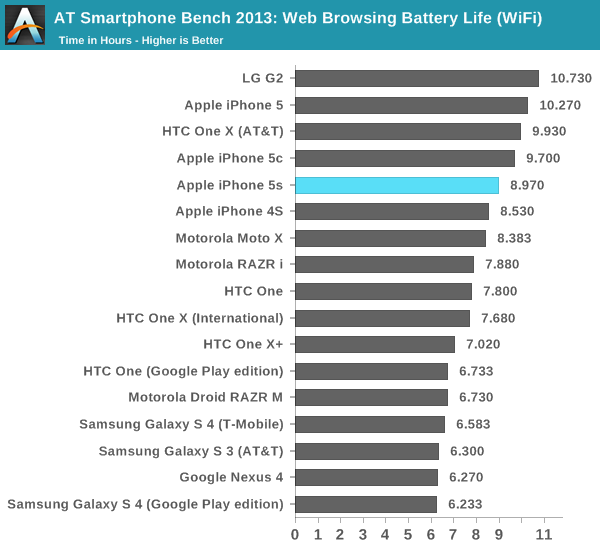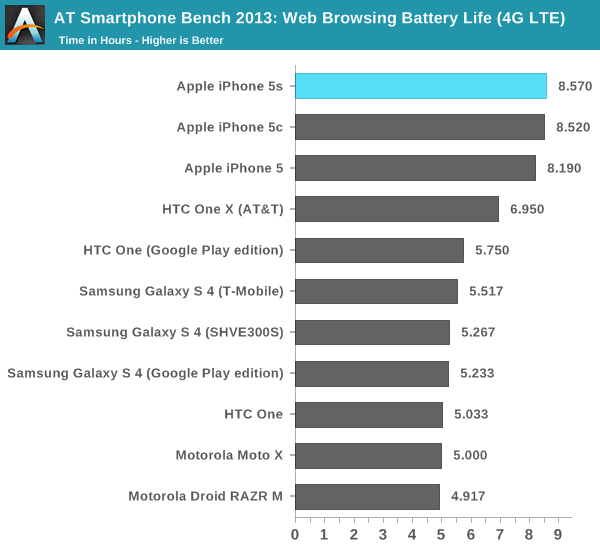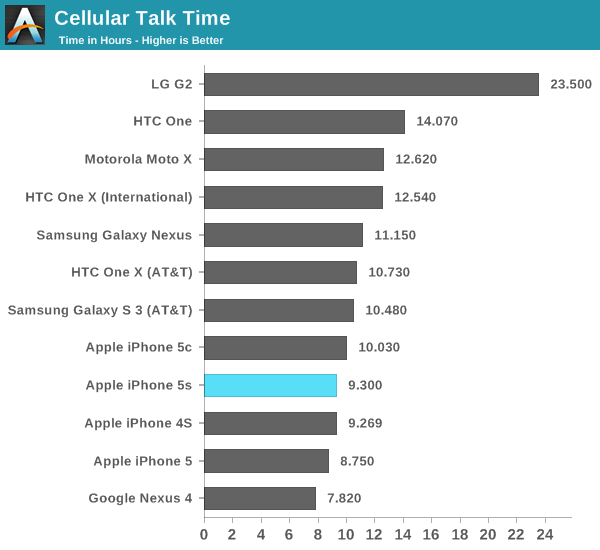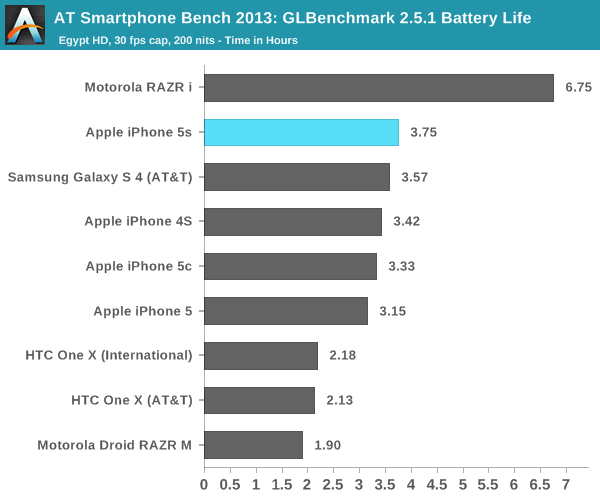The iPhone 5s Review
by Anand Lal Shimpi on September 17, 2013 9:01 PM EST- Posted in
- Smartphones
- Apple
- Mobile
- iPhone
- iPhone 5S
Battery Life
Brian did some excellent sleuthing and came across battery capacities for both the iPhone 5s and 5c in Apple’s FCC disclosures. The iPhone 5 had a 3.8V 5.45Wh battery, while the 5s boosts total capacity to 5.96Wh (an increase of 9.35%). The move to a 28nm process doesn’t come with all of the benefits of a full node shrink, and it’s likely not enough to completely offset the higher potential power draw of a much beefier SoC. Apple claims the same or better battery life on the 5s compared to the iPhone 5, in practice the answer is a bit more complicated.
Unlike previous designs, we’ve never had a half node shrink for an s-SKU. Both the iPhone 3GS and iPhone 4S stayed on the same process node as their predecessor and drove up performance. In the case of the 3GS, the performance gains outweighed their power cost, while in the case of the iPhone 4S we generally saw a regression.
The iPhone 5s improves power consumption by going to 28nm, but turns that savings into increased performance. The SoC also delivers a wider dynamic range of performance than we’ve ever seen from an Apple device. There’s as much CPU power here as the first 11-inch MacBook Air, and more GPU power than an iPad 4.
To find out the balance of power savings vs. additional performance I turned to our current battery life test suite, which we first introduced with the iPhone 5 review last year.
We'll start with our WiFi battery life test. As always, we regularly load web pages at a fixed interval until the battery dies (all displays are calibrated to 200 nits).

The iPhone 5s regresses a bit compared to the 5 in this test (~12% reduction despite the larger battery). We're loading web pages very aggressively here, likely keeping the A7 cores running at their most power hungry state. Even the 5c sees a bit of a regression compared to the 5, which makes me wonder if we're seeing some of the effects of an early iOS 7 release here.
The story on LTE is a bit different. Here we see a slight improvement in battery life compared to the iPhone 5, although the larger battery of the 5s doesn't seem to give it anything other than parity with the 5c:

Our cellular talk time test is almost entirely display and SoC independent, turning it mostly into a battery capacity test:

You can see the close grouping of the smaller iPhones at the bottom of the chart. There's a definite improvement in call time compared to the iPhone 5. We're finally up above iPhone 4S levels there.

Our Egypt HD based 3D battery life test gives us the first indication that Rogue, at least running fairly light code, can be more power efficient than the outgoing 5XT. Obviously the G6430 implemented here can run at fairly high performance levels, so I'm fully expecting peak power consumption to be worse but for more normal workloads there's no regression at all - a very good sign.










464 Comments
View All Comments
ShAdOwXPR - Wednesday, September 18, 2013 - link
A7X win be a monster 130-150 GFLOPS that's Xbox 360 territory. Apple saying the A7 is a desktop class might be real with the benchmark numbers of the A7X...darkich - Thursday, September 19, 2013 - link
I expect the GPU on A7X to be even more impressive, approaching 200GFLOPS and easily beating the PS3/XBOX 360 in terms of graphical ability because of far more capable memory.It should be at least on par with the Intel HD 4000 at the fraction of TDP
AaronJ68 - Wednesday, September 18, 2013 - link
I only scanned the review, as I have a few things to do this afternoon. But tonight, during the baseball game, I plan on detailed read-through. Thank you.On the other side of the coin, iTunes Radio just played a Ke$ha song ... so ... :)
Onemanbucket - Wednesday, September 18, 2013 - link
Anand,I signed up here just to say that is the best, most educated review I have ever read. I was swaying between iPhone 5S and a Windows device (925) but your clear enthusiasm for the technology her has swung it.
Cheers.
Jumangi - Wednesday, September 18, 2013 - link
The advanced SoC is one part of making a quality day to day phone. Apple sticking to a tiny 4' screen in 2013 should be called out as unacceptable from any enthusiast site like Anandtech.beggerking@yahoo.com - Wednesday, September 18, 2013 - link
only 2 core...any multithreaded benchmark comparison vs typical Android quad cores?kinshadow - Wednesday, September 18, 2013 - link
What made you guess the 6430 over the 6400? I don't see anything in the article that really points either way.Gorgenapper - Wednesday, September 18, 2013 - link
Recently switched from an iPhone 4S to a Galaxy S4 Active. Two observations....with regards to what Anand said about iPhone users switching out of frustration:1) I would have been happy with a 4.5" ~ 4.7" screen on an iPhone. The IPS LCD panels on the iPhones are of the best quality and calibration in the industry, with the HTC One's screen coming a very close second place (not sure about the LG G2's, never seen one in person). But a 4" screen is too small, let alone the 3.5" screen on my iPhone 4S, and I just got sick of waiting for Apple to wake up.
2) iTunes
I can see #1 coming true when the iPhone 6 is up next, but #2 will never change.
darkcrayon - Wednesday, September 18, 2013 - link
And you need iTunes for what on a daily basis? That's a plus IMO, I like having an easy option for disk based backups and sync to multiple devices. I use it on Mac OS X though.Gorgenapper - Wednesday, September 18, 2013 - link
I'm on a pc.1) iTunes forces me to keep a separate folder structure for pictures, as I have many high res pics, zip files, rar files that would get synced regardless. I have to maintain the pics in this folder as well as those in my main picture folder(s).
2) Movies on the device are inextricably linked to those on the iTunes library, I can't manually get those movies off the device even if I accidentally wiped out the movies on my computer.
3) Kind of iTunes related (locked down filesystem), but the Camera Roll on my device stores the pictures in randomly-named folders, and they're all generically named IMG_****. It's a real pain to find and extract photos using Windows Explorer.
4) I can't use any free space on the phone to transport files like a USB drive (minor issue)
5) iTunes is slow to boot up, and the interface is not as intuitive (to me) as a simple Windows Explorer window.
6) I have often run into a problem where I manually delete a movie off my iPhone to make room for shooting video, then go to resync it and iTunes doesn't realize that the movie is missing - I have to unsync all the movies that are currently on the iPhone, then resync them all to get that movie back.